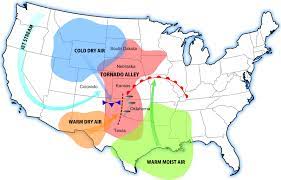Starting somewhere around March every year, a large swath of the country braces for hail. Known as Hail Alley, the region stretching from Wyoming to Texas receives more hailstorms, and more severe ones, compared to other parts of the country.
Features on land and in the atmosphere make perfect hail conditions for this part of the U.S.
In this article, we will explore how climate change could effect three of the hardest hit states that reside in the path of Hail Alley.
How will Climate Change effect Kansas?
Temperature
Kansas’s climate is changing. In the past century, most of the state has warmed by at least half a degree (F). The soil is becoming drier.
Rain / Snow
Climate change is creating an “unprecedented” risk of severe drought in the Southwest and Central Plains. Rising temperatures and decreasing rainfall mean that future drought could be more extreme than any drought seen in at least the past 1,000 years and the effects could reverberate for urban dwellers and farmers across the regions.
Winters
Warming winters and changes in the timing and size of rainfall events have altered crop yields. Over the next several decades, the amount of rainfall during the wettest days of the year is likely to continue to increase, which would increase flooding.
Hail Occurrences
The environmental conditions for large hail development are not changing with climate warming and that all favorable environments are equally likely to produce large hail.
Resources: Climate Central,
How will Climate Change effect Colorado?
Temperature
The climate of the Intermountain West is changing, with multiple independent measurements indicating an overall warming of about 2°F across the region in the past 30 years. In 2020, Colorado experienced its seventh warmest year in more than a century of record-keeping. Average temperatures were 2.8 degrees higher than the average in the past century. 2016 through 2020 was the hottest-ever five-year period for the state, according to the NOAA’s National Center for Climate Information.
Rain / Snow
Coloradans are experiencing what is called a “snow drought.” This is what Colorado forecasters are talking about when they say snow cover across the West is lower than at any time over the past two decades. Snowpack is less than 80% of normal statewide with less than two months to keep building.
Hail Occurrences
The effects of climate change on hail and the resulting damage are hard to calculate because hailstorms require distinct ingredients, and global warming affects them in different ways.
To form, hailstorms require moisture, an updraft, variable winds and freezing temperatures at lower levels of the storm cloud.
Updrafts lift water droplets into the clouds, where they attract other droplets and freeze together, scientists say. Winds of varying speed and direction keep the droplets suspended in the cloud long enough to grow into hailstones. When they eventually fall, freezing temperatures in the cloud keep them from melting before they hit warmer air closer to the ground.
Climate change will likely increase updrafts, helping hailstones form, but it will inhibit two hail-producing conditions. Warmer temperatures will expand higher into the atmosphere, so falling hailstones have more time to melt before hitting the ground. And differences in wind speed and direction will subside.
Climate change will make the atmosphere moister, but the effect that will have on hailstones isn’t clear..
Resources: CPR, Andreas Prein – National Center for Atmospheric Research in Boulder, Colorado. Colorado Sun,
How will Climate Change effect Texas?
Temperature
Texas is home to 9 of the hottest cities in the U.S., with McAllen in the 2nd slot. Most of the state of Texas has warmed between one-half and one degree (F) in the past century. Texas is home to 9 of the hottest cities in the U.S., with McAllen in the 2nd slot.
Rain
Despite the increase in heavy storms, changing climate is likely to make water less available overall. As warmer temperatures increase evaporation and water use by plants, soils are likely to continue to become drier. Average rainfall is likely to decrease during winter, spring, and summer. Seventy years from now, the longest period without rain each year is likely to be at least three days longer than it is today. Increased evaporation and decreased rainfall are both likely to reduce the average flow of rivers and streams.
Snow
In the case of the Texas cold snap, the phenomenon began in the first week of January 2021, when air in the stratosphere above the Arctic warmed suddenly. This set up a slow-moving atmospheric chain reaction that weakened the polar vortex, the girdle of winds that keeps frigid air corralled at the North Pole, allowing it to spill out into the temperate regions of Asia, Europe, and North America. Once the cold starts rolling south, very little can stop it.
While these events happen about six times per decade, according to the National Oceanic and Atmospheric Administration, Cohen maintains that climate change has increased the frequency with which the polar vortex weakens and allow the cold to air to run amok.
Hail Occurrences
Based on research, there is some indication of more intense hailstorms in a warming climate. Since the 1960s, the annual number of reported hail observations has risen, both in frequency and the size of the hailstones. That rising trend, however, does not necessarily mean climate change is resulting in more hailstorms with larger hail, and could simply indicate that as populations grow, there are more people, living in more areas, able to send in hail reports.
